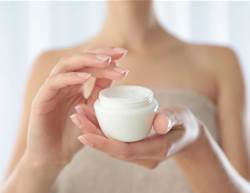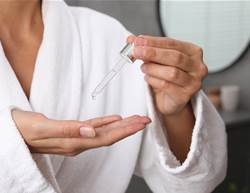Have you ever felt confused by all the skincare options for ageing skin? Managing your changing skin as you move through perimenopause, menopause and post-menopause can be overwhelming. As innovation lead, research and development manager at Advanced Skin Technology, I’ve learnt a lot about how to keep your skin healthy, whatever your age.
What skin changes may happen
First let’s break down each stage and what you may be noticing. You reach menopause when you have not had any periods for a year. The average age of menopause is 51 years, reports Health Direct. However, you can experience changes and symptoms before menopause. This transition is called perimenopause and can last several years. Post-menopause period refers to the years following menopause.
Menopause includes changes to your hormone levels. Women can feel the effects of the decline of oestrogen levels physically to varying degrees of severity, where some of the most common symptoms are hot flushes, insomnia and mood changes.
Oestrogen plays a major role in maintaining the health and appearance of the skin. Here’s how:
Hydration: Oestrogen influences the production of hyaluronic acid, a substance that helps the skin retain moisture. As hyaluronic acid declines, skin can become drier, and the barrier can become impaired, leaving skin more sensitive. Itchy, dry or sensitive skin is one of the most common symptoms in perimenopause.
Healing: Sebum (an oily substance) production and barrier lipids (fats) can become irregular. This leads to a compromised skin barrier and changes in the skin’s ability to heal.
Less collagen = more wrinkles: Oestrogen promotes collagen production and helps to maintain skin firmness and elasticity, so as oestrogen levels decline, collagen production can decrease, leading to sagging and wrinkles.
Skin thinning: The top two layers of skin gradually become thinner, and cell turnover slows, leading to a rougher texture and more visible capillaries, dark circles and uneven pigmentation.
Skin tone and appearance: Changes in oestrogen levels can affect pigmentation, leading to conditions like melasma (hyperpigmentation) or uneven skin tone. The skin also becomes less able to remove cell waste which is where age spots may occur.
Healthy habits for skin TLC
Microcirculation (blood flow) delivers nutrients to the skin and declines as we age. Between the ages of 20 and 70 years old, microcirculation is reduced by 40%.
Get your sweat on: One of the most important ways to keep skin youthful and maintain adequate circulation is to remain active, especially with exercise that makes your skin sweat and flush.
Prioritse sleep: Getting enough sleep is also vital for skin health. Difficulties in sleeping is a common problem in peri and post-menopausal women. Your doctor may recommend menopausal hormone therapy or medication to help you sleep.
Eat healthily: A simple rule for maintaining or introducing a healthy diet is to always eat foods closest to their natural form and you can’t go wrong. Avoid pre-packaged, high sugar and processed foods.
Wear sunscreen every day: Don't forget to slip, slop, slap! Even if you have a low-maintenance beauty routine, you can't avoid this one.
Maintaining a good skincare routine can go a long way to protecting and correcting some of the above visible signs of ageing, so let’s have a closer look at how this can be achieved. Remember consistency is key. Settle on a regime and stick to it for at least six months so you can see the results.
Must-have skincare ingredients for ageing skin
Your skincare products need to maintain good hydration and lipid (fat) balance; this is the cornerstone of healthy skin. Products that reinforce the skin barrier will help the skin to retain moisture and suppleness. Good barrier-building ingredients like essential fatty acids and humectants will maintain the correct balance and help to protect the skin from developing sensitivities.
Invest in cosmeceutical products that contain proven ingredients designed to support the skin during hormonal change. Ingredients like the below are a great starting point when considering skincare.
- Tranexamic acid: The beauty of this ingredient is the powerful, proven effect on brightening and evening out discolouration of the skin. It is very well tolerated and the best option for sensitive skin types.
- Vitamin C: This is a potent antioxidant that are crucial in protecting the skin from free radical damage that is caused by environmental and intrinsic (internal) age factors. Vitamin C is number one product for maintaining collagen and addressing signs of photodamage on the skin.
- Niacinamide: This ingredient is the gold standard of age protecting ingredients. It acts as a powerful antioxidant to protect the skin from environmental damage, increases ceramide synthesis which is vital for the skin barrier, and improves pigmentation and sallow skin, especially when combined with Vitamin C.
- Isoflavones: Derived from soy extract, these phyto-estrogenic compounds are good for supporting skin integrity and keeping menopausal skin firm and toned.
- Antioxidants: As the skin ages the antioxidant defence capacity begins to rapidly decline, so it’s an important component to daily skincare. There are many highly effective antioxidants in skincare products, especially plant based phyto-compounds like resveratrol.
To optimise results, there are other ingredients that play a key role when supporting skin during peri-menopause and menopause. Look for active ingredients like the following.
- Retinoids: Retinoid-based skincare is a great way to combat the signs of ageing as these ingredients have benefits such as improved skin texture and reducing hyperpigmentation and wrinkles, while improving firmness. There can be some side effects such as sensitivity to sunlight and dryness, so daily SPF and a good nourishing moisturiser are must-have complimentary products. Stronger retinoids require a prescription, so your dermatologist can talk to you about side effects.
- Peptides: These ingredients can provide an extra boost for maintaining collagen integrity, and maintaining skin density and are best used long term.
- AHAs: Skin turnover begins to slow as we age, reducing the natural shedding of dead cells which can leave skin dull, with a rough texture. AHAs improve the natural exfoliation process aiding in a fresher, smoother skin, as well as improving the appearance of excess pigmentation.
Want to learn more? Read 5 Anti-Ageing Skincare Ingredients That Actually Get Results and 3 Changes That Happen to Your Skin After Menopause.










